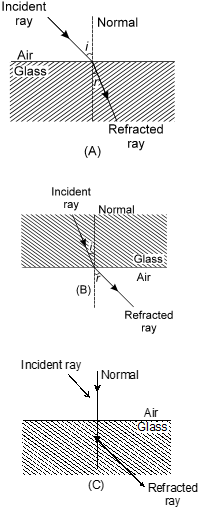- Books Name
- CBSE Class 7 Science Book
- Publication
- Param Publication
- Course
- CBSE Class 7
- Subject
- Science
Refraction of light :
When light travels in the same homogeneous medium, it travels along a straight path. However, when it passes from one transparent medium to another, the direction of its path changes at the interface of the two media. This is called refraction of light.
The phenomenon of the change in the path of the light as it passes from one transparent medium to another is called refraction of light. The path along which the light travels in the first medium is called incident ray and that in the second medium is called refracted ray. The angles which the incident ray and the refracted ray make with the normal at the surface of separation are called angle of incidence (∠i) and angle of refraction (∠r) respectively.

• It is observed that :
(i) When a ray of light passes from an optically rarer medium to a denser medium, it bends towards the normal (∠r < ∠i ), as shown in figure (A).
(ii) When a ray of light passes from an optically denser to a rarer medium, it bends away from the normal (∠r > ∠i) as shown in figure (B) .
(iii) A ray of light travelling along the normal passes undeflected, as shown in figure (C). Here ∠i = Ðr = 0°.
Cause of Refraction :
Refraction occurs because the speed of light is different in different media. Light travels with a greater velocity in a rarer medium like air and with lower velocity in a denser medium like glass or water.
The lower the velocity of light in the medium than that in air, the greater the bending because the greater would be the need to take a shorter path.

 Grow Career Publication
Grow Career Publication
 Param Publication
Param Publication
